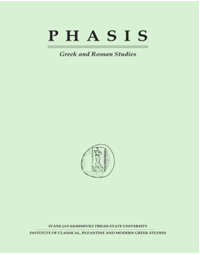Mad Dance: From Bacchus to Rock
DOI:
https://doi.org/10.60131/phasis.17.2014.2315Abstract
Bacchic dance, a remarkable element of ancient culture, held an important place in the Dionysiac cult from early times. It frequently attracted poets, artists, sculptors and even historians. Though the Bacchantes sank into oblivion over centuries, the practice of mad dance used to rebound in powerful bursts at different times and in different cultures. In this regard, in the paper, the attention was attracted by medieval Europe, occasionally inundated by strange mad dance, and by modern-day rock festivals. What happens in medieval Europe and in our contemporary world? What is the repercussion of the Bacchic dance in the 13th-17th and in the 20th-21st centuries? What do they look like? And what is the difference among these dances? There are the questions examined in the paper. The behavioural ‘symptoms’ of the Dionysian, as well as their triggers, have persisted over centuries. Whether in antiquity, in the Middle Ages or in the 20th-21st century, mad dance outbreaks are invariably associated with social frustration and spontaneity and occur as the awaking of something latent but constantly present in humans. The only difference lies in the intention of these mad behaviours: in ancient Greece, the Bacchic dance was seen as a path towards divine communion, in the Middle Ages it was a treatment against dance itself, while now it marks defiance and revolt against reality.Downloads
Published
2014-05-17
Issue
Section
Articles
License
Copyright (c) 2014 PHASIS

This work is licensed under a Creative Commons Attribution-NonCommercial 4.0 International License.


